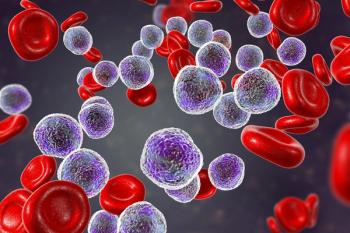
- ONCOLOGY Vol 14 No 7
- Volume 14
- Issue 7
Permanent Prostate Brachytherapy: Lessons Learned, Lessons to Learn
Dr. Potters has provided an excellent and timely overview of transperineal interstitial permanent prostate brachytherapy (TIPPB). The historical context, as the title suggests, nicely illustrates the lessons already learned and those still to be learned. There are a few points I would like to discuss in further detail.
Dr. Potters has provided an excellent and timely overview of transperineal interstitial permanent prostate brachytherapy (TIPPB). The historical context, as the title suggests, nicely illustrates the lessons already learned and those still to be learned. There are a few points I would like to discuss in further detail.
Importance of Local Control
As Dr. Potters pointed out, the poorer results in the earlier retropubic series may have been due to technically inadequate implants, ie, suboptimal dose. Studies have demonstrated that not only was local control inferior with lower-dose implants but freedom from distant metastases and overall survival was compromised as well.[1] Conversely, in prospective randomized trials using fast-neutron radiation therapy, enhanced local control has been associated with significant increases in overall survival.[2] Recently at Fox Chase, improvements in biochemical and local control using high-dose three-dimensional (3D) conformal external-beam radiation therapy have translated into better survival rates as well.[3]
The importance of technically sound permanent implants cannot be overstated and, as these data demonstrate, adequate dose is directly related to local control, which, in turn, correlates with survivala situation not always observed in radiation oncology.
Role of Androgen Deprivation
Dr. Potters contends that neoadjuvant androgen deprivation does not add much benefit as seen in his own data.[4] However, another interpretation of the same data could be that the therapy was, in fact, quite successful. The prostate volumes in the cohort that received neoadjuvant androgen deprivation were nearly 80 cc, in contrast to 35 cc in patients who did not receive this therapy.
The fact that the disease control outcomes were equivalent could mean that neoadjuvant androgen deprivation successfully downsized the prostates in these patients, making TIPPB feasible. The lack of difference in biochemical no-evidence-of-disease rates suggests that the downsized glands were implanted with technical adequacy.
The fact that no benefit in disease control was observed with neoadjuvant androgen deprivation may, in part, be due to patient selection. Low-risk patients have not been shown to benefit conclusively from adjuvant hormonal therapy when combined with external-beam radiation therapy; there may also be no reason to expect a benefit when the therapy is combined with TIPPB in low-risk patients.
In high-risk patients, the prospective randomized trials that have revealed a benefit to hormonal therapy with external-beam radiation therapy have used either prolonged (at least 3 years) luteinizing hormone-releasing hormone (LHRH) agonists[5,6] or a neoadjuvant approach with total androgen blockade[7] (ie, an LHRH-agonist and an androgen-receptor blocker). Whether brachytherapy combined with prolonged LHRH-agonist therapy or combined with neoadjuvant total androgen blockade would be more effective than the short-term neoadjuvant LHRH-agonist therapy typically used is presently unknown.
Role of External-Beam Radiation
The importance of radiation dose escalation in prostate cancer is now well established. Techniques employed to achieve this include 3D treatment planning with conformal techniques (3D CRT), intensity-modulated radiation therapy (IMRT), and proton therapy. Brachytherapy can also be considered as a means of escalating the dose further. When a brachytherapy boost is used in conjunction with external-beam radiation therapy, the highest physical doses of radiation for prostate cancer are attained.
Although Dr. Potters own data do not support the addition of external-beam radiation therapy to TIPPB; other data do support the combination. Ragde et al[8] have observed equivalent disease control in patients who received external-beam radiation therapy along with TIPPB compared to those who received implants alone, despite significantly worse prognostic features in the former group. When they used a stricter definition of biochemical control (prostate-specific antigen [PSA] < 0.4 ng/mL), the addition of external-beam radiation therapy proved significantly better despite the worse prognosis of these patients.
Critz et al[9] employed a similarly strict definition of biochemical control (PSA < 0.5 ng/mL) and reported excellent actuarial biochemical control rates (92% at 5 years) using TIPPB combined with external-beam radiation therapy. This group has been performing the implants before beginning external-beam radiation.
We have also been using a similar reverse sequence. With this strategy, the tumor receives more radiation per day than with the conventional sequence since the implanted seeds are still emitting radiation at the time of external irradiation.
There is a theoretical radiobiological advantage; the low-dose radiation may sensitize the tumor cells to the subsequent high-dose external-beam radiation therapy.[10] The sequence also permits some flexibility in that the external-beam radiation therapy dose can be adjusted to compensate for a suboptimal implant. Perhaps most significantly, during TIPPB, we have been implanting fiducial seed markers that are visible on both simulation and port films to assure precise tumor localization and setup reproducibility during conformal external-beam radiation therapy.
Radiation Dose From TIPPB With Palladium-103
Finally, as Dr. Potters points out, Blasko et al[11] have recently reported excellent results using palladium-103 (103Pd) implants alone. Considering that the average volume of the prostate expands 70% after TIPPB[12] with iodine-125 (125I) or 103Pd and shrinks back down with a half-life of well over a week, one might expect poorer results with 103Pd. That is, the shorter half-life of 103Pd implies that most of the prescribed dose is actually being delivered to a target significantly larger than initially assumed. During the time in which the bulk of the dose is delivered, the individual seeds are farther apart than initially anticipated and, thus, areas within the gland are receiving less than the planned dose.
The fact that the clinical results are as good as they are suggests that the actual dose of radiation from standard 103Pd implants may be considerably higher than the prescribed 115 Gy. A reanalysis of the actual dose from 103Pd seeds is underway.
James S. Welsh, MD
References:
1. Laramore GE, Krall JM, Thomas FJ, et al: Fast neutron radiotherapy for locally advanced prostate cancer: Final report of an RTOG randomized clinical trial. Am J Clin Oncol 16:164-167, 1993.
2. Fuks Z, Leibel SA, Wallner, et al: The effect of local control on metastatic dissemination in carcinoma of the prostate: Long-term results in patients treated with I-125 implantation. Int J Radiat Oncol Biol Phys 21:537-547, 1991.
3. Hanks GE, Hanlon AL, Pinover WH, et al: Survival advantage for prostate cancer patients treated with high-dose three-dimensional conformal radiotherapy. Cancer J Sci Am 5:152-158, 1999.
4. Potters L, Torre T, Ashley R, et al: Examining the role of neoadjuvant androgen deprivation in patients undergoing prostate brachytherapy. J Clin Oncol 18:1187-1192, 2000.
5. Bolla M, Gonzalez D, Warde P, et al: Improved survival in patients with locally advanced prostate cancer treated with radiotherapy and goserelin. N Engl J Med 337:295-300, 1997.
6. Pilepich MV, Caplan R, Byhardt RW, et al: Phase III trial of androgen suppression using goserelin in unfavorable-prognosis carcinoma of the prostate treated with definitive radiotherapy: Report of Radiation Therapy Oncology Group Protocol 85-31. J Clin Oncol 15:1013-1021, 1997.
7. Pilepich MV, Krall JM, al-Sarraf M, et al: Androgen deprivation with radiation therapy compared with radiation therapy alone for locally advanced prostatic carcinoma: A randomized comparative trial of the Radiation Therapy Oncology Group. Urology 45:616-623, 1995.
8. Ragde H, Elgamal AA, Snow PB, et al: Ten-year disease free survival after transperineal sonography-guided iodine-125 brachytherapy with or without 45-gray external beam irradiation in the treatment of patients with clinically localized, low- to high-Gleason grade prostate carcinoma. Cancer 83:989-1001, 1998.
9. Critz FA, Levinson AK, Williams WH, et al: Simultaneous radiotherapy for prostate cancer: 125I prostate implant followed by external-beam radiation. Cancer J Sci Am 4:359-363, 1998.
10. Williams JR, Xhang Y-G, Dillehay LE: Sensitization processes in human tumor cell during protracted irradiation: Possible exploitation in the clinic. Int J Radiat Oncol Biol Phys 24:699-704, 1992.
11. Blasko JC, Grimm PD, Sylvester JE, et al: Palladium-103 brachytherapy for prostate carcinoma. Int J Radiat Oncol Biol Phys 46:839-850, 2000.
12. Badiozamani KR, Wallner K, Sutlief S, et al: Anticipating prostatic volume changes due to prostate brachytherapy. Radiat Oncol Investig 7:360-4, 1999.
Articles in this issue
over 25 years ago
Non–Small-Cell Lung Cancer Single-Agent Therapyover 25 years ago
Linezolid-A New Option for Treating Gram-Positive Infectionsover 25 years ago
Current Issues in the Treatment of Resistant Bloodstream Infectionsover 25 years ago
Changing Patterns of Infections and Antimicrobial Susceptibilitiesover 25 years ago
Ambulatory Antimicrobial Therapy for Hematologic Malignanciesover 25 years ago
Questions and Answers: Non–Small-Cell Lung Cancerover 25 years ago
Questions and Answers: Small-Cell Lung Cancerover 25 years ago
Irinotecan in Small-Cell Lung Cancer-Japanese TrialsNewsletter
Stay up to date on recent advances in the multidisciplinary approach to cancer.


















































































